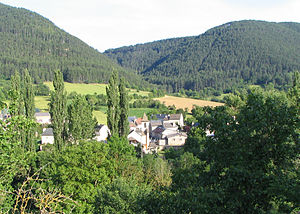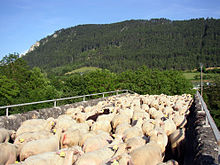Esclanèdes
| Esclanèdes | ||
|---|---|---|
|
|
||
| region | Occitania | |
| Department | Lozère | |
| Arrondissement | Mende | |
| Canton | Chirac | |
| Community association | Aubrac Lot Causses Tarn | |
| Coordinates | 44 ° 29 ′ N , 3 ° 22 ′ E | |
| height | 627-1,001 m | |
| surface | 12.51 km 2 | |
| Residents | 392 (January 1, 2017) | |
| Population density | 31 inhabitants / km 2 | |
| Post Code | 48230 | |
| INSEE code | 48056 | |
 Village view |
||
Esclanèdes is a French mountain community with 392 inhabitants (as of January 1, 2017) in the Lozère department in the Occitanie region .
geography
Esclanèdes is located in the Massif Central in the Cevennes National Park on the Causse de Sauveterre in the Lot River valley , 105 kilometers northwest of Montpellier and 12 kilometers southwest of Mende . Neighboring communities of Esclanèdes are Grèzes in the north-west, Cultures in the east, Balsièges in the south-east and Chanac in the south-west. The municipality covers 1251 hectares, the mean height is 814 meters above sea level , the Mairie stands at an altitude of 644 meters.
Esclanèdes is assigned to a type Cfb (according to Köppen and Geiger ) climate zone : warm, moderate rainy climate (C), fully humid (f), warmest month below 22 ° C, at least four months above 10 ° C (b). There is a maritime climate with a moderate summer.
history
At the beginning of the Huguenot Wars (1562–1598) the church of Saint-Hippolyte, which is consecrated to Saint Hippolytus of Rome , was burned down by Huguenots and only rebuilt in 1630.
Attractions
A Gothic bridge crosses the Lot and connects the district of Esclanèdes with the district of Le Bruel . Its construction was commissioned by the Bishop of Mende François de La Rovère († 1524).
The Château de Marance is now privately owned. Originally the place where it stands was called Amaranza , an Amaranza farm was mentioned in a document in 1389. The castle itself dates from the 17th century, the current farm was only built in the 18th or 19th century.
The Saint-Hippolyte church dates back to the 13th century, burned down in 1562 and rebuilt in 1630. The sacristy was added in 1721. The church tower was only built in the 19th century. There are several works of art from the 18th and 19th centuries in the church.
economy
Important occupations in Esclanèdes are trade, transport, industry and agriculture ( breeding of domestic sheep and poultry as well as meat industry ). In the municipality, there are controlled designations of origin (AOC) for Bleu des Causses and Roquefort (cheese) and Protected Geographical Indications (IGP) for beef (Géisse Fleur d'Aubrac) , poultry (Volailles du Languedoc) and lamb (Agneau de Lozère) . Young female cows that have not yet calved are called Genisse . The Géisse Fleur d'Aubrac has an Aubrac mother and a Charolais father.
Web links
- Esclanèdes in the Base Mémoire des Ministère de la Culture (French)
- Esclanèdes on cartesfrance.fr in French
- Déscription de la commune du Bruel d'Esclanèdes on ot-chanac.fr (Office de Tourisme de Chanac) in French
Individual evidence
- ↑ a b Visite de la commune d'Esclanèdes-Le Bruel (French).
- ↑ a b Le village d'Esclanèdes. In: Annuaire-Mairie.fr. Retrieved October 26, 2012 (French).
- ↑ Le Bruel d'Esclanèdes on vivreaupays.pro (French) Retrieved March 18, 2015.
- ↑ entry no. 48056 in the Base Mérimée of the French Ministry of Culture (French).
- ↑ entry no. 48056 in the Base Palissy of the French Ministry of Culture (French).
- ↑ Esclanèdes - Dossier complet on insee.fr in French, accessed on March 18, 2015, cf. Section Chiffres clés caractéristiques des entreprises et des établissements .
- ↑ Fleur d'Aubrac presentation. In: viande-aubrac.com. AVBA station Raciale de la Borie de l'Aubrac, accessed on October 26, 2012 (French).

